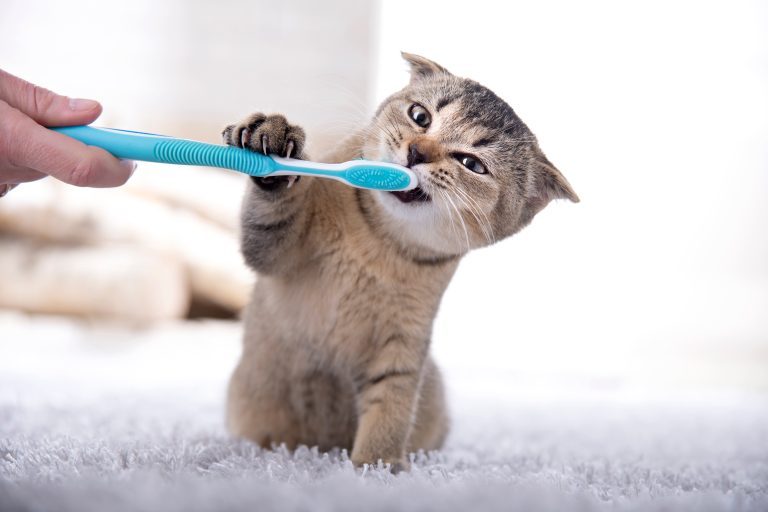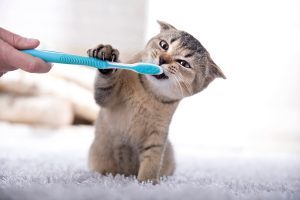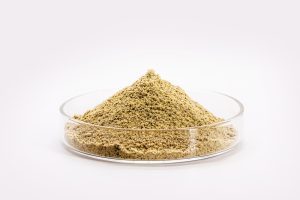How nutrition impacts pets’ intestinal and oral health
In recent years, pets have come to occupy an increasingly significant place in people’s lives. With declining birth rates, delayed parenthood, and increased life expectancy, many pet owners now see their animals as faithful family members, a phenomenon known as the humanization of companion animals. This behavioral shift has driven a new approach to care: more attentive, personalized, and preventive.
Today’s “pet parents” are more informed and demanding, seeking products and services that promote not only immediate well-being but also long-term health. In this context, topics such as oral and gut health have gained strategic relevance, especially when considering the development of nutritional products for companion animals.
To ensure that food is fully utilized and its nutritional benefits optimized, it is essential to maintain health throughout the entire digestive tract, which begins in the mouth. Therefore, ensuring pets’ oral health is the first step toward efficient nutrition and overall well-being. Good nutrition is only fully effective when there is a balance between oral and intestinal functions.
Pet oral health goes far beyond aesthetics or bad breath. Issues such as tartar buildup, gingivitis, and tooth loss impair chewing, hinder proper food intake, and reduce digestive efficiency. Proper chewing not only facilitates food ingestion but also initiates the mechanical and enzymatic breakdown of nutrients.
In dogs and cats, although chewing is less prolonged than in humans, it still plays a vital role in preparing food for the gastrointestinal tract. Moreover, untreated oral infections can trigger systemic diseases, affecting vital organs such as the heart and kidneys.
According to experts at Cornell University’s College of Veterinary Medicine, between 50% and 90% of cats over the age of four show some form of dental disease. This statistic reinforces the need for early preventive care.
But the journey of nutrition doesn’t end in the mouth. The gut is primarily responsible for transforming ingested food into energy, immunity, and vitality. It is where essential nutrients are absorbed, pathogens are defended against, and the immune system is regulated through the gut microbiota.
The large intestine, in turn, is responsible for fiber fermentation, stool formation, and microbiota maintenance, an ecosystem of microorganisms that directly influences immunity, metabolism, and even pet behavior.
This mouth-gut connection has driven a growing trend to integrate nutritional solutions that promote both oral and digestive health in pets. In the United States, for example, 53% of pet owners who purchase food or treats for their animals want to see benefits related to healthy digestion in the products¹, a reflection of the increasing awareness of digestive health and the demand for products with proven functionality.
Therefore, integrated care for oral and gut health is essential to ensure pets fully benefit from their diet, maintain a balanced microbiota, and enjoy a healthier, more active, and longer life.
Throughout this article, we will explore how the pet industry can benefit from functional ingredients, such as yeast, to promote strategic and complete nutrition that respects the physiology of dogs and cats and contributes to lasting systemic health. Get ready to discover how science, nutrition, and care come together to transform pet health.
THE IMPORTANCE OF PET NUTRITION
Pet nutrition has undergone a true revolution in recent decades. From a model focused solely on satiety and palatability, it has evolved into a functional, strategic, and science-based approach. This advancement reflects the changing role of pets in society and directly impacts their health and longevity.
Proper nutrition can provide a range of benefits that go far beyond weight maintenance or satiety. It strengthens the immune system, improves coat and skin quality, enhances food digestibility, helps prevent chronic diseases such as obesity, diabetes, and joint problems, and positively influences pets’ behavior and vitality.
Diets formulated with functional ingredients and balanced according to the pet’s life stage and clinical condition can improve inflammatory responses, reduce oxidative stress, and promote a balanced gut microbiota. These factors together result in a longer, more active, and healthier life.
To understand this impact, it is essential to differentiate between two fundamental concepts: feeding and nourishing. Feeding refers to the act of providing food to the animal, the physical consumption of ingredients. Nourishing, on the other hand, means ensuring that the ingested food is transformed into energy, tissues, defenses, and vital functions.
Nutrition ensures that nutrients are absorbed, metabolized, and used efficiently. This distinction is crucial because it highlights that feeding alone is not enough; nourishment must be purposeful and of high quality.
To nourish properly, it is necessary to understand the ingredients in the diet and how they interact with the animal’s body. The correct selection and use of nutritional additives, such as fermentable fibers, prebiotics, probiotics, antioxidants, and functional yeasts, are essential to promote health and well-being.
These ingredients directly influence microbiota modulation, intestinal mucosa integrity, and immune response, contributing to a healthy gastrointestinal tract, which is fundamental for efficient nutrient absorption and systemic health.
This solid nutritional foundation also connects directly to oral and intestinal health. A healthy gut contributes to a more balanced oral microbiota, reducing plaque formation and gum inflammation. Conversely, good chewing and oral health support digestion and nutrient absorption. This connection between the two systems has driven the development of integrated nutritional solutions.
Given all this, what are the opportunities in the pet food market?
OPPORTUNITIES IN THE PET MARKET
The growing humanization of companion animals has profoundly transformed the pet market. With pet parents increasingly attentive to their pets’ health and well-being, new demands have emerged for products that go beyond basic nutrition, requiring functional, preventive, and personalized solutions. This movement opens space for innovations that meet the expectations of pet parents while respecting the physiology of animals.
1. Functional nutrition as a competitive advantage
The search for foods that offer specific benefits, such as immune support, digestive health, weight control, and longevity, has driven the growth of categories like premium and super premium pet foods, as well as nutritional supplements.
Functional ingredients such as yeasts, prebiotics, probiotics, antioxidants, and fermentable fibers are increasingly present in formulations, adding value and positioning products as health allies.
According to market research, 53% of pet parents in the United States want to see digestive benefits in the foods and treats they buy¹. This data reflects a global trend of valuing gut health as the foundation for systemic well-being and reinforces the importance of developing products that work “from mouth to gut.”
2. Oral and gut health as pillars of innovation
The interdependence between oral and digestive health opens opportunities for integrated solutions. Investing in products that promote digestive health and, consequently, oral health is a strong trend valued by pet parents.
After all, a pet with a healthy gut shows various signs of well-being, such as strengthened immunity, healthy skin and coat, and even behavioral improvements. This perception has driven the growth of categories like functional foods, supplements, and treats with specific health claims.
Products that reduce plaque, control tartar, and balance oral microbiota can be combined with ingredients that support digestion and nutrient absorption. The use of prebiotics and probiotics in pet foods is expanding, as these ingredients help balance gut flora and improve digestion. Around 20% of global launches of treats for dogs and cats highlight digestive health benefits².
At the same time, oral health has also gained relevance: 19% of dog food launches featured claims related to tartar prevention and dental issues, while 9% of cat food launches included this benefit². Additionally, 31% of consumers reported purchasing dental/oral care products for their pets in the past 12 months³.
These data reflect a growing trend: interest in foods that not only nourish but also offer additional health benefits, such as digestive, immune, and oral support.
In China, for example, 33% of pet parents say they would be willing to pay more for products enriched with functional ingredients¹, highlighting a clear opportunity for growth and differentiation in the global market.
These ingredients offer a comprehensive approach that respects pet physiology and meets pet parents’ expectations for products with proven functionality.
3. Segmentation and personalization as growth strategies
With advances in nutritional science and access to data on pet behavior and health, there is an increasing opportunity to develop products segmented by age, size, breed, lifestyle, and clinical conditions. This personalization allows brands to serve specific niches, such as senior pets, those with digestive sensitivities, or predisposition to oral diseases, and strengthens the connection between brand and consumer.
This scenario shows that the pet market is in complete expansion, and that functional nutrition, especially when it integrates oral and gut health, is one of the main opportunities for innovation and differentiation in the industry.
Thaila Cristina Putarov, Global Business Manager for Animal Nutrition and Health at Biorigin, shares valuable insights about the pet market: “The pet market is increasingly driven by conscious choices and the search for solutions that promote holistic health. At Biorigin, we believe that natural and functional ingredients, such as yeast, are essential to meet pet parents’ expectations and add value to animal nutrition formulations.”
Market trends show the need for innovative nutritional solutions, and Biorigin stands out as the ideal partner to support the animal nutrition industry, promoting the health and well-being of dogs and cats with natural ingredients backed by science and aligned with modern consumer demands.
BIORIGIN’S YEAST AS AN ALLY FOR PETS’ GUT AND ORAL HEALTH
With over 20 years of experience, Biorigin develops natural-origin ingredients designed to meet the needs of the pet food market for dogs and cats.
To ensure pets’ well-being and health, with a special focus on oral and gut health, we offer innovative solutions developed with quality and expertise:
MACROGARD, extracted from Saccharomyces cerevisiae yeast through a process that preserves the molecular structure, has high bioactivity and a minimum concentration of 60% beta-glucans. Key benefits include:
- Strengthens the immune system;
- Effective for oral health in pets with naturally occurring periodontal issues, check out the study;
- Improves vaccine response in puppies;
- Supports joint health;
- Contributes to the metabolism of obese animals, such as reducing glucose levels.
ACTIVEMOS, obtained from the yeast cell wall through a primary pure culture production process, has a high concentration of functional compounds. Rich in mannan-oligosaccharides (MOS), it acts as a substrate for the gut microbiota, stimulating the production of short-chain fatty acids essential for digestive health. Key benefits include:
- Stimulates the growth of beneficial bacteria;
- Balances gut microbiota by agglutinating pathogens;
- Preserves intestinal barrier integrity, promoting greater health and well-being.
“At Biorigin, we combine biotechnology, innovation, and natural-origin ingredients to develop solutions that meet the demands of the pet market. Our yeast-based products have proven benefits for intestinal, immune, and oral health, promoting well-being and quality of life with safety and efficacy”, João Koch, Global Technical Manager Feed at Biorigin.
For more information about Biorigin and our natural-origin yeast and yeast extract solutions, visit our website.
Sources:
¹ Mintel – A year of innovation in pet food, 2025
² Mintel – Patent insights: revolutionise the future of pet food
³ Mintel – Global Consumer – March 2025 – The Holistic Consumer
4 Cornell University’s College of Veterinary Medicine








